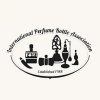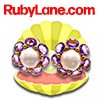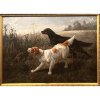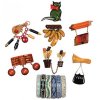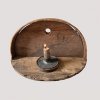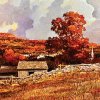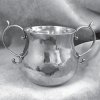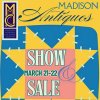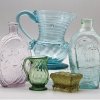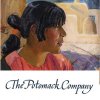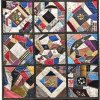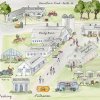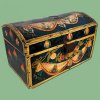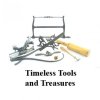The Last Harry B. Hartman Sale
November 21st, 2015
Conestoga Auction Company, Manheim, Pennsylvania
Photos courtesy Conestoga Auction Company
The Conestoga Auction Company, a division of the Hess Auction Group, sold the last of Harry Hartman’s worldly goods on November 20 and 21, 2015, in Manheim, Pennsylvania. It took three two-day cataloged sales in May, August, and November to disperse the collection and stock that the Marietta, Pennsylvania, dealer, designer, and collector had accumulated for more than 60 years. Hartman was known for his good taste and passion for Pennsylvania country gear in all mediums, and the sales attracted a large local audience and strong participation online and on the phones. The three unreserved sales, 2541 lots, realized $2,042,544.79 (includes buyers’ premiums).
This last sale began with books on Friday and ended with furniture on Saturday. In between, there were all manner of ceramics, woodenware, metalware, and paintings. The 829 lots brought a total of $679,768.50, topping the presale estimates of $333,520/518,000. (Presale estimates are always figured without the 18% buyers’ premiums.) Books, kugels, and furniture brought less than expected, while woodenware, stoneware, redware, weathervanes, paintings, and fraktur generally brought more than estimated.
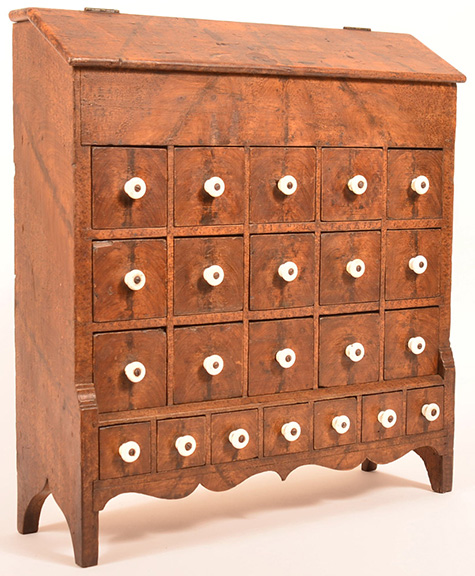
This grain-painted mixed wood seed chest, attributed to John Boyer of Brickerville, Lancaster County, has a hinged lid and three rows of five drawers above a row of seven smaller drawers. Cigar boxes were used for the drawer sides and bottoms. Measuring 21½" x 19" x 6¼", it sold for $17,700 (est. $1000/1500) to the agent for the major buyer at all the Hartman sales. At the height of the market, Conestoga sold other painted seed chests by Boyer (with the same drawer arrangement and in pristine condition inside and out); one of them sold for $75,900 in 2005.
The agent for a private collector who was a major buyer at all three sales was active again and rarely the underbidder. He paid $17,700 for a grain-painted seed chest attributed to John Boyer. A 15" high four-gallon stoneware pottery crock, made in Maryland or Pennsylvania, was his for $2714. He won an Ohio sewer tile figure of a Spaniel for $1888 and two Peaseware canisters for $501.50 and $442.50. A dovetailed cherry cutlery tray with appealing cutouts was his for $531, but a Pennsylvania hanging salt box with an arched backboard and old red surface cost him $2006. He bought two weathervanes: a copper fish for $5015 and a hackney stallion trotting, with some gilt remaining, for $12,980. He got two lots of brown and blue glazed marbles for $590 and $885. A colorful fraktur birth and baptism certificate with angels, hearts, and tulips cost him $5546. He bought a Henry Hahn (Reading) 30-hour clock in a case with bold graining for $3540, a hoop-back bamboo-turned Windsor chair for $649, and a bow-back Windsor armchair for $885.
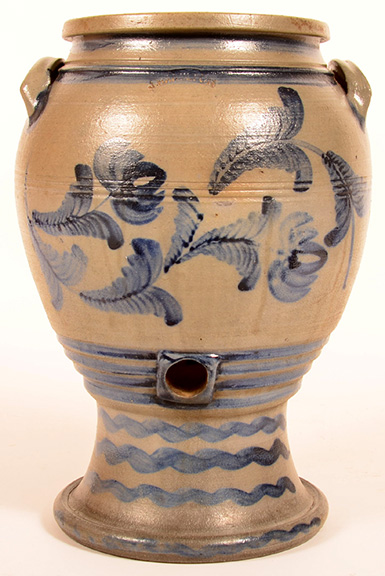
Three phone bidders and bidders in the salesroom competed for this western Pennsylvania 18¾" high stoneware four-gallon water cooler stamped “J. Hamilton” on the top blue band. It has cobalt-blue decoration and applied ear handles and is missing its lid. It sold on the phone for $14,160 (est. $800/1200). Collector Mike Pell said he drove all the way from Pittsburgh to buy it but dropped out at $7000. “It’s very rare. Only a few are known, and it’s marked,” he said. James Hamilton of J. Hamilton & Co. was a potter in Greensboro, Pennsylvania, in the last quarter of the 19th century and is known for his very large crocks.
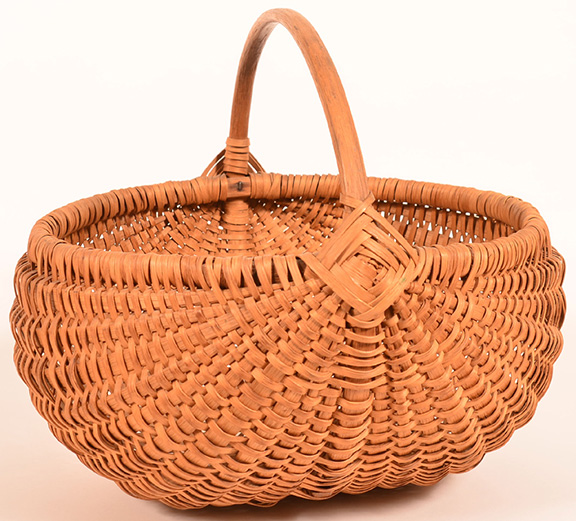
In good condition, this 16½" high x 18" wide Pennsylvania woven oak splint basket with bentwood handle with a god’s eye reinforcement and bentwood wrapped rim sold on the phone for $885 (est. $200/400). The same phone bidder paid $708 for an oak splint berry basket (not shown), just 3" high x 5¼" wide.
The top lots of furniture went to the trade in the room or online. Philip Bradley bought a 1770-80 Lancaster County architectural painted softwood schrank, its base with faux drawers, its cornice anchored by complex pilasters, for $31,860. In April 2014 at Pook & Pook, Harry Hartman had bought it for $102,000 and said it was for his own use. He had owned it once before and wanted it back.
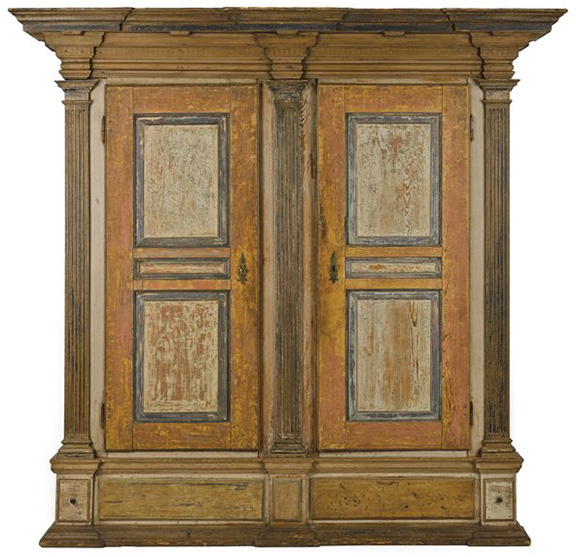
This rare Lancaster County, Pennsylvania, architectural polychrome-painted softwood schrank, 1770-89, with fluted columns, raised panels, stepped molded base with faux drawers, and dry scraped paint surface is 87¾" x 89" x 34½" and sold in the salesroom for $31,860 (est. $30,000/50,000) to dealer Philip Bradley of Downingtown, Pennsylvania, in the salesroom. At Pook & Pook in April 2014, Harry Hartman had bought it for $102,000 and said he had owned it before and sold it to a Texas woman. He had wanted it back in his own collection.
This market misses Harry Hartman—if he wanted something, he rarely was the underbidder. Take away the top buyer and the market suffers. It is likely the underbidder for the schrank at Pook & Pook in 2014 was the winner of the schrank this time around. It’s considered an architectural masterpiece.
Eric Kramer of Greg Kramer & Co. got a good buy when he bought two similarly decorated dower chests painted in Dauphin County. One, dated 1809 and with the owner’s initials in the center of three arches, sold for $5900; the other, dated 1806, sold for $3540.
 Paintings by David Ellinger and his half-sister Mabel Lambert sold well, thanks to a Harrisburg collector who bought the large Ellinger farm scene for $4425, a small framed Ellinger bird for $2006, and Mabel Lambert’s folky painting of a black family selling flowers for $4366.
Paintings by David Ellinger and his half-sister Mabel Lambert sold well, thanks to a Harrisburg collector who bought the large Ellinger farm scene for $4425, a small framed Ellinger bird for $2006, and Mabel Lambert’s folky painting of a black family selling flowers for $4366.
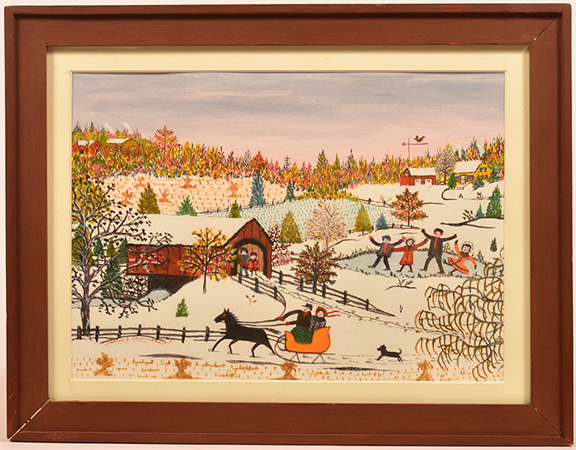
This 1976 winter scene by Hattie K. Brunner is a 10" x 14" watercolor in an original Hattie Brunner 14¼" x 18¼" frame. It sold to a phone bidder for $5605 (est. $2500/3500).
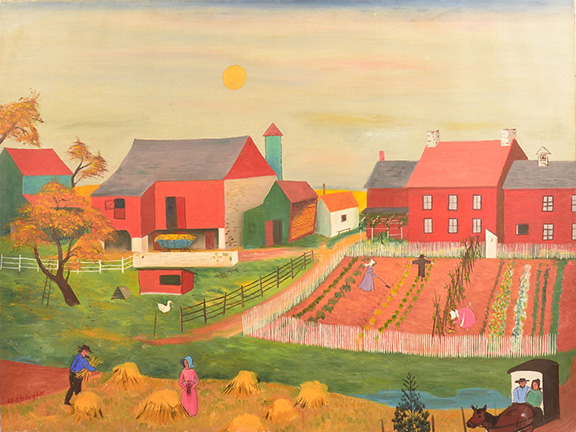
This 30¼" x40¼" Amish farm scene, an oil on canvas by David Ellinger, sold to a collector in the salesroom for $4425 (est. $2000/4000).
Bidders were willing to pay top dollar for high-quality redware and stoneware. Art Booth of Wayne, New Jersey, paid $5310 for an 8½" redware plate with an expressive slip decoration made with a four-spout slip cup. Where will you find another? A phone bidder paid $3186 for an ovoid polychrome redware jar said to have been made in the Shenandoah Valley, and another phone bidder paid $14,160 for a stoneware four-gallon water cooler marked “J. Hamilton.”
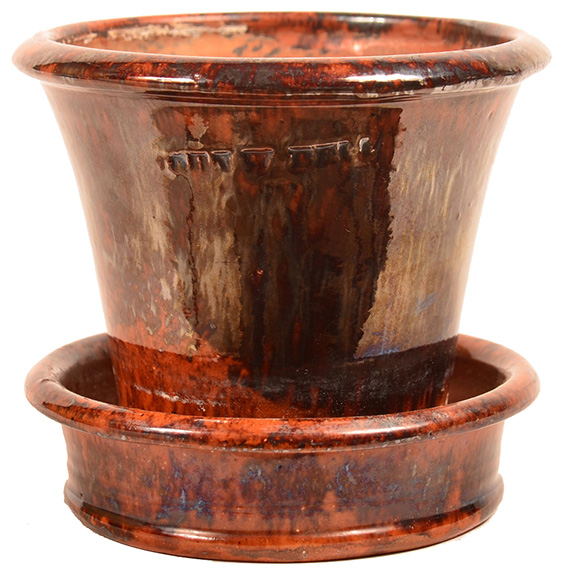
This mottled-glaze flowerpot, 5¾" x 6½", sold for $2242 (est. $500/600). The potter stamped “John W. Bell” on it. He worked in Waynesboro, Pennsylvania.
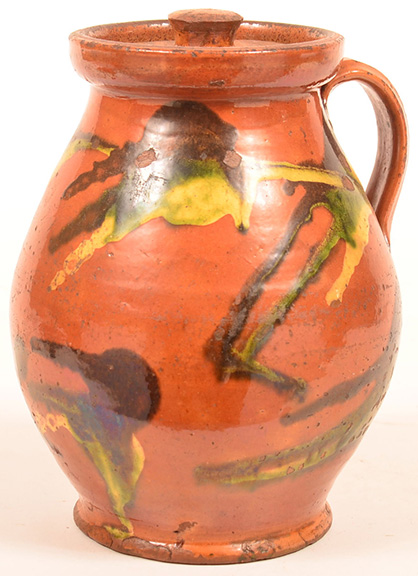
This Shenandoah Valley redware storage jar with polychrome decoration, 9½" high, has a small chip and repairs. It sold to a phone bidder for $3186 (est. $300/500).
John Hess said that about 25% of the sale on Saturday went to Internet bidders and 22% on Friday. He used two bidding platforms: LiveAuctioneers and Bidsquare. LiveAuctioneers broke down twice and each time asked for 15 minutes to fix the glitch.
During the first 15-minute recess Hess said, “This is a good commercial for Bidsquare; this will give all the bidders time to sign on to Bidsquare.” He said more bidders used LiveAuctioneers, but Bidsquare, the new kid on the block, is gaining. Its website is user friendly, it reports prices after the sale with premium included, and the full catalog descriptions are available with a click on the image. Often there were bidding battles between the two platforms, and often a bidder in the crowded salesroom prevailed.
Conestoga has been attracting some first-rate collections. On view during the Hartman sale were highlights from the collection of collector/dealer Corinne H. Machmer, who has decided to downsize and sent her entire collection to Mainheim to be sold on February 26 and 27. It includes ceramics of the highest quality, spatterware, and other English wares made for the American market and more, all collected long ago and now fresh to market.
For more information, contact Conestoga at (717) 898-7284 or check the website (www.conestogaauction.com).
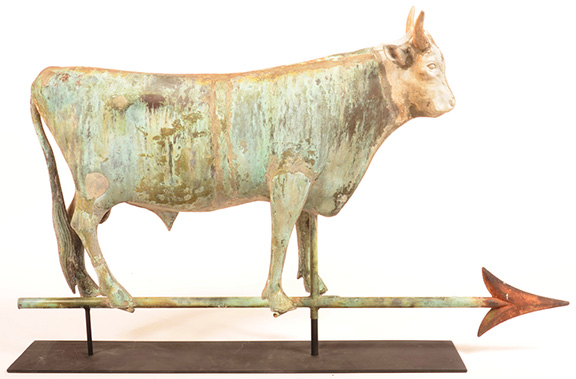
This 23" high x 43½" long (overall) copper weathervane of a bull with a cast zinc head mounted on an arrow directional, with some gold leaf and verdigris surface, sold for $18,880 (est. $3000/5000) to collectors in the salesroom.
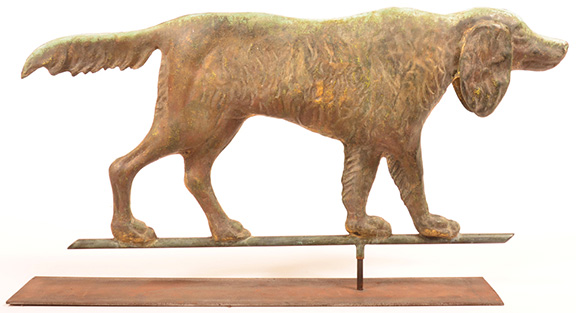
This copper weathervane in the form of a setter dog and attributed to Washburn has some remnants of gilt. The 17½" high x 32½" long vane sold on the phone for $12,980 (est. $3000/5000).

This Pennsylvania 19th-century wrought-iron flesh fork with a penny end with hanging eyelet and three prongs with central heart, 24¾" long, sold for $2242 (est. $200/400).
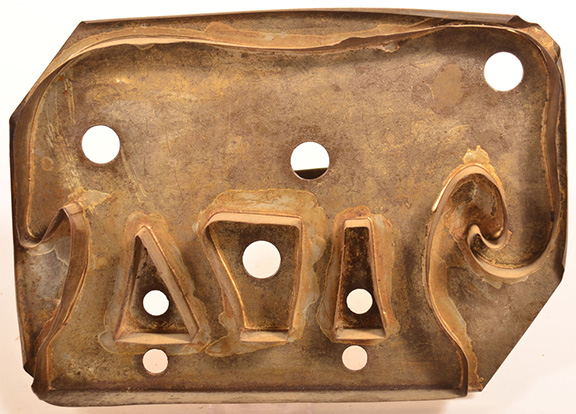
This large (7 3/8" high x 10½" wide) elephant tin cookie cutter, signed “G. Endriss / 700 N Street Phila” on the handle, sold for $1121 (est. $100/200).
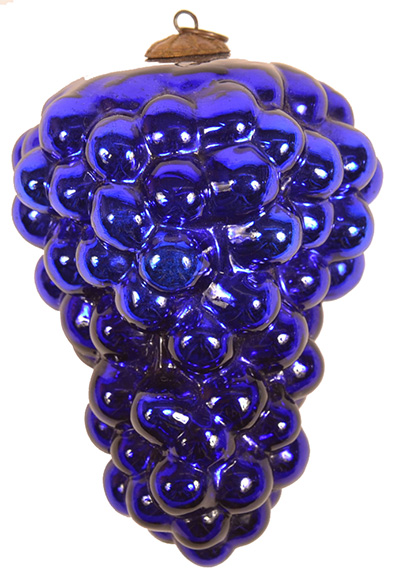
This blown blue glass cluster of grapes, a 4½" high German kugel, sold for $472 (est. $300/500) and was the most expensive of the 28 kugels in this last Harry Hartman sale. Most sold under estimates; ten brought less than $50 each. Two 4¼" in diameter green balls and a 3¾" in diameter green glass ball sold for just $11.80 (est. $100/300) each. The rare kugels were in the first two sales.
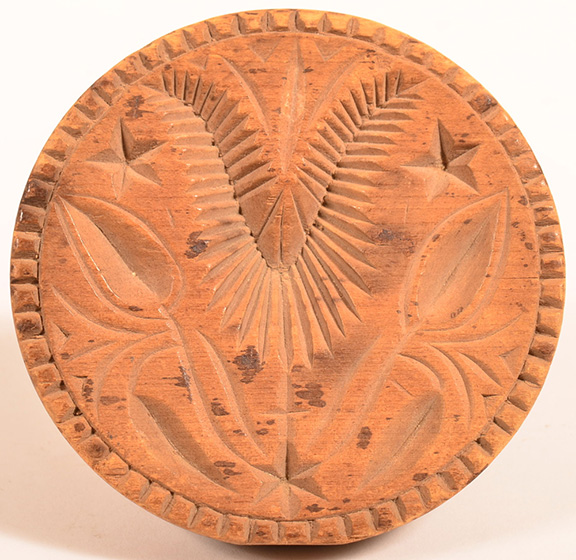
This 19th-century wood tulip-pattern butter print sold for $1062 (est. $100/300) to John Rogers of New Hampshire, a specialist dealer in woodenware who bought most of the butter prints in the sale.
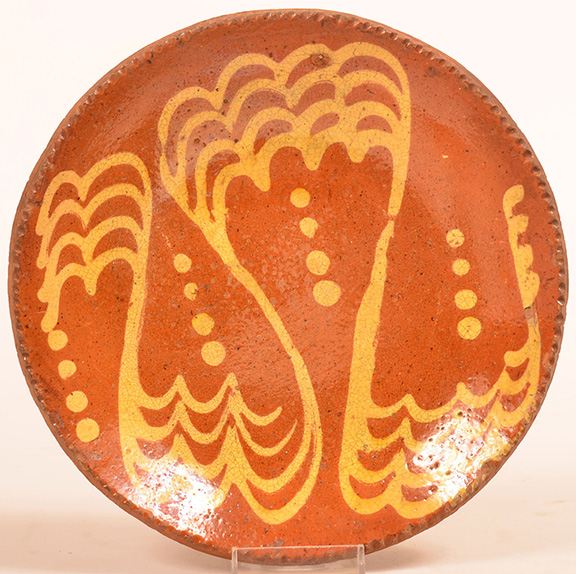
This Pennsylvania 8½" diameter slip-decorated redware plate sold in the salesroom to collector/dealer Art Booth of Wayne, New Jersey, for $5310 (est. $500/800). It is a rare size, and its bold decoration provoked keen competition.
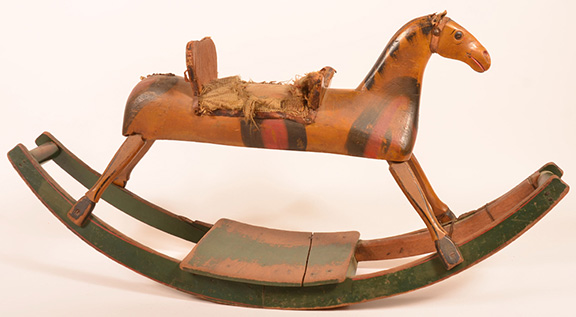
This child’s painted wood rocking horse sold for $2006 (est. $300/500) to dealer Gene Rappaport of Strasburg, Pennsylvania. It is stamped on its belly “B.P. Grandall & Co. / 49 / Courtlandt St. / N.Y.” and measures 22" x 44½". It is painted with blue, green, and red paint on a yellow ground.
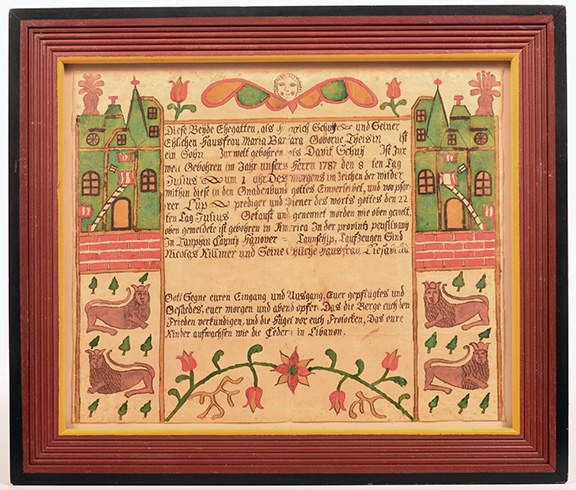
This 13" x 16" hand-drawn and painted birth and baptism, attributed to Christian Mertel and dated 1787, has an angel, houses, crowned lions, and flowers. The text, translated from German, reads: “To this married couple, Henrich Schuy and his wife Maria Barbara, nee Theis, a son was born into the world as David Schuy. (He) was born into the world in the year of Our Lord 1787, on the 8th day of July at one o’clock in the morning under the sign of Aries. (He) was baptized through the everlasting glory of God by Pastor Lup on the 22nd day of July. (He) was born in America, in the state of Pennsylvania, Dauphin County, Hanover Township and the sponsors were Nicolas Killmer and his wife Liesabetta.” It sold for $11,210 (est. $3000/5000). It has been published by Corinne and Russell Earnest in their books on fraktur and was once in the collection of Richard Machmer.
Originally published in the February 2016 issue of Maine Antique Digest. © 2016 Maine Antique Digest






